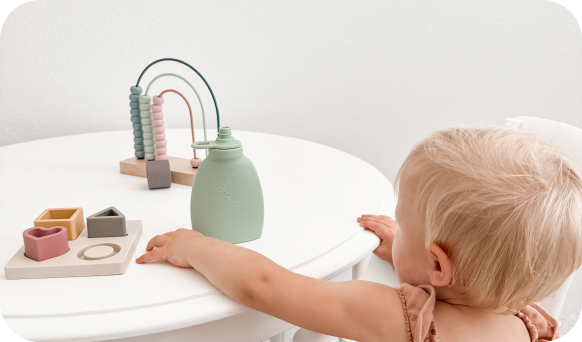Why Our Daughter’s First 10 Months Looked So Different

Hi, I’m Anna. I’m just a mom learning as I go and sharing what actually works at our house. When Theo was a baby, I used store-bought pouches more than I like to remember. I did not choose them because I thought that they were the best option, but because I was a first-time mom and really did not know better.
But by the time Julia came along, I had a new plan. I wanted her to start life with real food from day one. That meant getting intentional about what went into her little tummy. I began making baby puree recipes at home with fresh nutritious food: squash, pear and carrots. Her first baby food was not from a plastic pouch with an extensive list of fillers and preservatives.
It was from one of our reusable pouches, fit to enjoy without fillers and additives. In this guide, you’ll see how our feeding journey changed with Julia and get simple tips to make homemade baby food part of your routine. Read on to learn more.
Why We Changed Our Approach
With Theo, I assumed baby food came in a package from the store. I didn’t know there was a better way. Now, after a few years of parenting under my belt, I see how much those early food choices matter. By starting Julia on homemade baby puree from the start, I felt confident about every ingredient.

I followed baby food stages so she could try the right textures and flavors at the right time. It wasn’t just about health; it was about setting her up for a lifetime of enjoying real food.
Understanding Baby Food Stages
If you’ve ever been confused about baby food stages, you’re not alone. I had no idea they even existed when Theo was little. Here’s what I learned this time around:
Stage 1 Baby Food: Super smooth purées made from a single ingredient. Perfect for 4–6 months. Take mashed avocado, pear puree, or roasted sweet potato blend until silky.
Stage 2 Baby Food: Go for slightly thicker purees, often mixing two or more ingredients. This is where you can get creative, like blending apples and carrots or mixing bananas with spinach.
Stage 3 Baby Food: Chunkier textures with small soft pieces to help babies learn to chew. At this stage, you might mash foods with a fork instead of blending them into a smooth consistency.
Knowing these stages made feeding Julia so much easier. I didn’t have to guess what was safe or appropriate; I just followed the progression, and she thrived.
Want to learn more? Read our guide on The Ultimate First Foods Timeline
Our Go-To Baby Puree Recipes
One of the best parts of making your own baby puree recipes is the fun you can have. I could try new combinations based on what was in season or what we had on hand. Here are a few of Julia’s favorites:

Creamy Carrot and Apple: Steam carrots and apple slices until soft, then blend until smooth. Sweet and bright in flavor.
Squash and Pear Puree: Roast butternut squash, steam ripe pear, and blend them together for a cozy fall-inspired flavor.
Green Pea and Avocado Mash: Blend cooked peas with ripe avocado for a creamy, nutrient-rich puree.
Blueberry and Banana Smooth Puree: Blend fresh or thawed blueberries with a ripe banana for a sweet and tangy treat.
These baby puree ideas are quick to make, freeze well, and work perfectly in reusable pouches for on-the-go feeding.
Stage 1 Baby Food: Starting Strong
When Julia was ready for solids, I didn’t rush. I started with stage 1 baby food, giving her single-ingredient purees one at a time. This way, I could watch for any reactions and let her adjust to new flavors. Her first bites? Butternut squash, mashed until velvety.
Then came pear puree, avocado, and sweet potato. Watching her face light up as she tasted each one was priceless. Making stage 1 baby food at home isn’t hard. You just need fresh produce, a steamer or pot, and a blender. The bonus? You control exactly what goes in no added sugar, no preservatives.
How Julia Eats Now at 10 Months
Julia is now 10 months old and eats more variety than Theo did at twice her age. She has her favorites, like roasted zucchini sticks and mashed avocado but she’s also open to trying new flavors. She happily drinks fruit-and-veggie smoothies from her reusable pouches.
She snacks on tiny bites of soft scrambled eggs. She even munches on soft-cooked carrots while sitting in her high chair. By starting early with homemade baby puree recipes and following baby food stages, I gave her a strong foundation for healthy eating.
Why Homemade Wins
I’m not here to judge anyone for using store-bought baby food; it can be a lifesaver sometimes. But here’s what I noticed when we switched to homemade:
- Julia’s digestion improved.
- She had fewer mood swings.
- She developed a taste for a wider variety of foods.
- I felt confident knowing exactly what she was eating.
If you want to avoid processed foods for your baby, starting with homemade stage 1 baby food is a great step.
Want to know more? Read our guide to get Easy Baby Food Recipes for Busy Moms
Quick Tips for Getting Started
If you’re ready to try making your own baby food, here’s what helped me:

- Start simple with single-ingredient purees.
- Use seasonal produce for better flavor and nutrition.
- Make batches and freeze portions for busy days.
- Store purees in reusable pouches to save time and reduce waste.
The Tools That Made It Easy
When you’re making your own baby food, having the right tools matters. Our Snack Time Combo Pack became my go-to. It’s perfect for storing baby puree in reusable pouches and holding solid snacks like cheese cubes, tiny meatballs, or cut-up fruit in cup as your baby grows.
For days when we were heading out, I also used our Little Smoothies System. It kept homemade smoothies and yogurt blends ready for quick feeding without a mess. With these tools, I didn’t have to choose between convenience and quality; I got both.
Conclusion:
Those first months taught me a simple truth: real food changes everything. When we skipped the store pouches and started fresh baby puree recipes, Julia ate better, felt better, and tried more foods. Following baby food stages kept me calm. It gave me a clear path, one small step at a time. Want the same peace? You can do this, too.
Ready to make it easy on yourself? Use the tools that helped us. Get the Snack Time Combo Pack for purées, yogurt, and real snacks on the go and grab the Little Smoothies System for quick blends your little one will finish.
References:
1. INRAE. (n.d.). When young children learn to eat a wide variety of textures. Retrieved from
https://www.inrae.fr/en/news/when-young-children-learn-eat-wide-variety-textures
2. Healthline. (n.d.). 21 Homemade Baby Food Recipes. Retrieved from
https://www.healthline.com/health/childrens-health/21-homemade-baby-food-recipes
3. BabyCenter. (n.d.). Baby food stages, explained. Retrieved from
https://www.babycenter.com/baby/solids-finger-foods/baby-food-stages-explained
